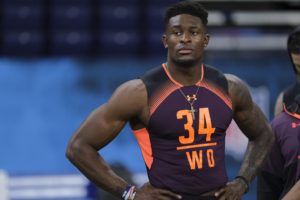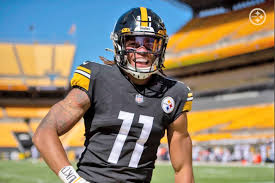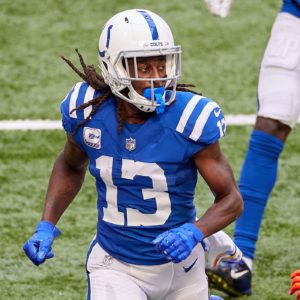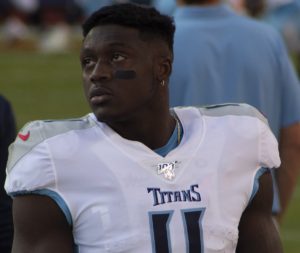Evaluating Rookie Wide Receivers
Evaluating wide receivers, specifically rookie receivers is increasingly difficult. Using Python and some useful packages, I ran a cluster analysis to group receivers based off their college production, physical profile and combine scores, all gleaned from PlayerProfiler. So what can college and the combine tell us?
This is partially for pure entertainment of the groupings and partially for knowledge as it is interesting to see what players are similar as a prospect, and how different types of prospects have different forms of success.
To put it simply, I used combine results from height to forty to vertical along with college yards-per-reception, dominator rating, target share and breakout age to try identify which prospects were similar.
The Unknowns
 These are the guys that just did not fit the mould. Either they were crazy athletic, dominated college or possessed elite physical traits, or in the case of some guys, they were none of the above. It was difficult to interpret the results here.
These are the guys that just did not fit the mould. Either they were crazy athletic, dominated college or possessed elite physical traits, or in the case of some guys, they were none of the above. It was difficult to interpret the results here.
Some notable individuals were Julian Edelman and Terrelle Pryor, two former quarterbacks. Pryor is unbelievably athletic but had no college production as a receiver so that explains his lack of colleagues in his grouping. It’s a similar story for Edelman, except he is not as physically gifted as Pryor, although his burst and quickness is elite and benefits him as a slot receiver. Others went to unknown schools that did not have their college production statistics recorded. This is unavoidable but I was pleasantly surprised that the model managed to separate these “anomalies” from the general groups. It’s very difficult to predict the success of people who go from playing one position in college to another in the NFL. These are our Wildcards.
A few individuals that understandingly have no peers were DK Metcalf, John Ross, Donovan Peoples-Jones, and Miles Boykin. Whether it was setting a new combine record in 40 yard dash or moving like a shorter man who weighs 30 pounds less, all these individuals set themselves apart from the pack. A few have burst onto the scene like Metcalf, whereas others like John Ross have a tough start to their career, despite their athletic prowess. This group is our Athletes.
Another category of individuals that intrigued me was the ones who dominated college football and didn’t test at the combine for one reason or another. The best of the bunch was Demaryius Thomas who only ran the forty. However, we do have a pair of Buccaneers in Justin Watson and Tyler Johnson, along with the offseason starlet Bryan Edwards who was meant to steal my Hunter Renfrow’s spot in Las Vegas. These are the College Heroes.
Big Name Groups
The Prototype
 Julio Jones is one of the best receivers of all time. He’s more athletic and technical than nearly everyone else in the league, and can still go off at any moment despite years of injuries and mileage. To be compared to Jones is a blessing and there were two rookies this year that got placed in his elite company.
Julio Jones is one of the best receivers of all time. He’s more athletic and technical than nearly everyone else in the league, and can still go off at any moment despite years of injuries and mileage. To be compared to Jones is a blessing and there were two rookies this year that got placed in his elite company.
Chase Claypool was a man who stunned the world both at the combine and in the NFL. Casually running a 4.42-forty paired with a 40-plus inch vertical, all at 6-4 and close to 240 pounds, Claypool scored 13 touchdowns in his first year in the NFL and may have just made Smith-Schuster expendable for the Steelers. Add in that he had a near identical college dominator rating and you would wonder how he fell to the second round.
The other lucky rookie was my favourite Denzel Mims, straight out of Michigan. At 6-3, he ran a sub-4.4 forty along with showing off the agility and explosiveness that helped him nearly average a touchdown a game in college football. Speaking of dominating college, Mims also had the highest college dominator rating whilst also possessing the lowest college target share.
This group was a personal favourite mainly due to how close they all are and how interesting the results were. A potential Julio Jones 2.0 was coming into the league, two of them actually and they both went in the second round?
The Little Rockets
 Yeah they’re probably above average in height or close to it, but in the grand scheme of things, these sub-6-footers are the minority on the field. This doesn’t mean they don’t dominate in their own way though. Many of these guys use their blazing speed or quickness to dominate in the slot, like Jamison Crowder and Golden Tate, or all over the field, like TY Hilton.
Yeah they’re probably above average in height or close to it, but in the grand scheme of things, these sub-6-footers are the minority on the field. This doesn’t mean they don’t dominate in their own way though. Many of these guys use their blazing speed or quickness to dominate in the slot, like Jamison Crowder and Golden Tate, or all over the field, like TY Hilton.
I loved Scotty Miller coming out of college, and compared him to TY Hilton and Tyler Lockett due to his agility, speed and natural ability to win in big opportunities. He did well this year as a sophomore, connecting with Tom Brady 33 times for just over 500 yards and three touchdowns. Not bad for a man out of Bowling Green. Another man who has shown glimpses of potential has been Christian Kirk, making up for his lack of height with some burst, quickness, and long-line speed.
These guys all had a few times in common: relatively productive in college, lack of elite physical traits, either quick or fast and sometimes both. One thing the model couldn’t pick up is that a lot of the players in this group are usually shoved into the slot, where they often dominate using their short-area quickness.
A few that created their own group but easily could have fit in here with a little more productivity in college were Hunter Renfrow and Braxton Berrios, one of whom who got mistaken for Derek Carr’s son.
Young Studs
 When a group has Chris Godwin, AJ Brown, Jerry Jeudy and Justin Jefferson then you just know that group must be quality. Well, a two other members are the infamous Nelson Agholor and Tre’Quan Smith, two guys that never really lived up to their potential. Laviska Shenault is an interesting inclusion here, showing his promise and potential if he continues to flourish as a Jaguar.
When a group has Chris Godwin, AJ Brown, Jerry Jeudy and Justin Jefferson then you just know that group must be quality. Well, a two other members are the infamous Nelson Agholor and Tre’Quan Smith, two guys that never really lived up to their potential. Laviska Shenault is an interesting inclusion here, showing his promise and potential if he continues to flourish as a Jaguar.
All of the players here are shorter than 6-3 but taller than 6 foot with good but not great speed and production. Where they make up for this is with their burst and early dominance in college, with all players breaking out in college before or just after their twentieth birthday.
Ballers Are Always Going To Ball
 De’Andre Hopkins and Stefon Diggs are the headliners of this group with Sammy Watkins and Jermaine Kearse being the most notable of the rest. All members of this group broke out before they turned 19 and were fairly dominant in college.
De’Andre Hopkins and Stefon Diggs are the headliners of this group with Sammy Watkins and Jermaine Kearse being the most notable of the rest. All members of this group broke out before they turned 19 and were fairly dominant in college.
Other Notable Groups:
Allen Robinson and DJ Moore
Corey Davis, Kenny Golladay, and Alshon Jeffery
AJ Green, Michael Gallup, Robby Anderson, and Zach Pascal
Tyreek Hill and Marquise Goodwin
Will Fuller, CeeDee Lamb, Tee Higgins, and James Washington
Larry Fitzgerald, Devante Parker, Adam Thielen, and Courtland Sutton
N’Keal Harry, Devin Funchess, Michael Floyd, and Allen Lazard
Davante Adams, Donte Moncrief, and Josh Doctson
Preston Williams and Jordy Neslon
John Brown and Anthony Miller
Martavis Bryant and DJ Chark
Cooper Kupp, Michael Crabtee, Demarcus Robinson, and Marvin Jones
Brandon Marshall, Michael Pittman, and Andre Holmes
Breshad Perriman, Mike Evans, and Equanimeous St. Brown
Brandon LaFell and Michael Thomas
What could this teach us?
Numbers matter, but so does film. Using numbers to find comparisons is great, and relatively easy to do, but technique and football IQ is what separates Chris Godwin from Nelson Agholor. Quantifying a grade for a prospect is difficult as there is so much to consider: strength of opponents, system, supporting cast, and much much more.
I nearly want to start a movement against statistics without context. It plagues fantasy football. Film experts miss out on statistics which help quantify a players impact. Number crunchers miss out on how polished a route-runner a receiver is. Who cares if someone had a specific grade if they only averaged five fantasy point per game? Winning your league is about maximising fantasy football points.
Use your numbers and your common sense. If someone is as productive as Justin Jefferson in college then backs it up with above-average testing numbers, then he’s more than likely an NFL-level receiver. If someone is the next coming of Calvin Johnson, take a chance. And if they test better than anyone else, then they may just be an athlete, not a football player. A fast forty or a big vertical isn’t all that matters. Just ask Julian Edelman.






